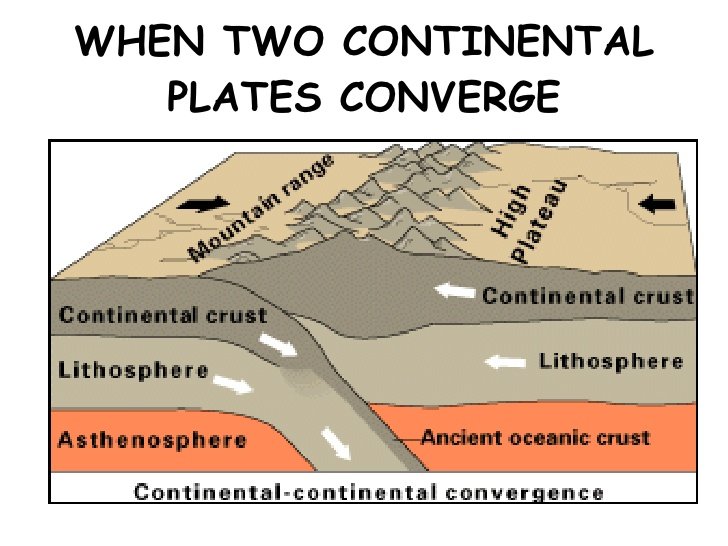FOLDING AND LAND FORMS
folding and land forms
Folding is the crumpling or wrinkling or bending of the rocks of the earth crust usually along defined line of weakness due to lateral forces of compression. The formation of fold is similar to the wrinkles formed when a piece of cloth is of the table is pressed on one side.
Folding is mostly clearly developed in sedimentary rocks may accumulate over millions of years to a great thickness and if lateral pressure is applied to this rock when they are still relatively “plastic” more flexible the readily fold up.
Characteristics of folds
folding is a gradual process which can take place for several thousand of years. Folds vary from few centimeters to thousands of kilometers and are responsible for most of the worlds great great mountain system. Where folding occurs part of the rocks move up to form an up fold or anticline while part move down to form down fold or syncline. The central line of the fold is called axis while the side are called the limbs.
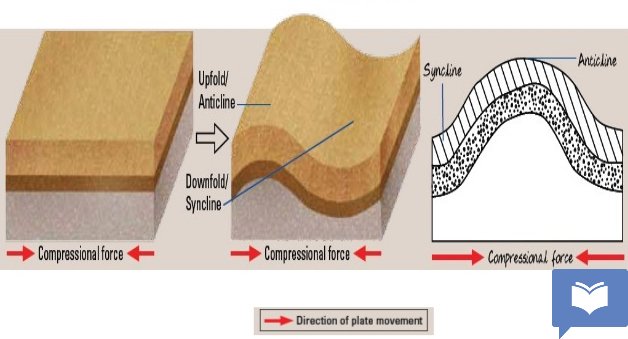
Before and after folding
TYPES OF FOLDS
Folding varies in magnitude or size depending on the strength of the forces of compression. These has resulted to several types of fold which include
- Simple of symmetrical fold
- Asymmetrical fold
- Over fold
- Recumbent fold
- Over thrust or nappe
Simple or symmetrical fold:
This is the simplest type of fold where the limbs are of equal steepness. This is because the force of compression of both sides are equal.
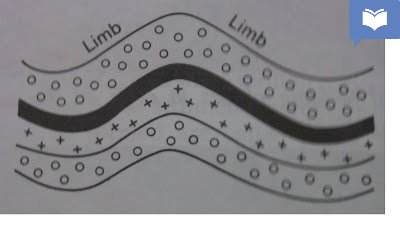
Diagram of Simple fold
Asymmetrical fold
When compression continues in a simple fold an asymmetrical fold develops. In this type of fold one limb is steeper than the other. This is due to the fact that the compressional force of one side of the fold is greater than that of the other.

Diagram of asymmetrical fold
Over fold:
Over fold occurs when forces of compression are so great in one side than the other such that one of the limbs on an anticline is pushed over the forming and over fold.

Diagram of an over fold diagram
Recumbent fold
As compression continues in an over fold, a recumbent fold develops. The folded rocks lie across the strata in front of the fold and the axial plane is vertically horizontally.

Diagram of recumbent fold
Overthrust fold
This type of fold occurred when severe lateral pressure occurs in a fracture or crack in the fold. When this happens, one limb is pushed along the fracture overt the other limb to produce a nappe.
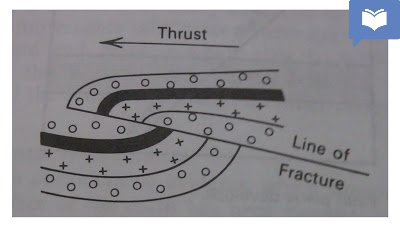
Diagram of overthrust fold
Anticlinorium and synclinorium
in some fold systems the main anticline and syncline may have numerous minor fold super impose upon them. anticline complex is called the Anticlinorium while the syncline complex is called the syncline.

diagram of syncline and sysnclimne
Summary of all folds
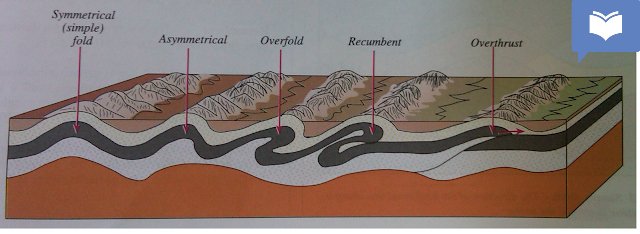
FEATURES PRODUCED BY FOLDING
Syncline valley:
A syncline valley are valleys formed at the down or syncline of a folded sedimentary rocks. The vary in size according to the strength of folding. Some syncline valleys are hundreds of meters deep. Broad shallow syncline so indeed often produced gentle sloppy basins. However, through syncline valley are much less common that might be expected examples of syncline valley include Paris basin and London basin.

Diagram of syncline valley
Fold mountains
Fold mountain are masses of folded sedimentary rocks, which may have a thickness of over 1200 meters. They are the most common and highest of all mountains. Fold mountain are produced by great compression forces that develop when tectonic plates move towards each other. This could be the coming together of an oceanic and a continental plate or the meeting of two continental plates.
Fold mountain due to the meeting of oceanic plate and continental plate
When an oceanic and a continental plate meet, the heavier oceanic plate goes beneath the plate descends the thick sediments that had accumulated between the two plate is compressed and eventually fold mountains are produced. Fold mountains formed in this way include the Andes and the Rocky Mountains.

Fold mountain due to the meeting of oceanic plate and continental plate
Fold mountain due to the meeting of two continental plates.
When two continental plates meet, the rocks between them are compressed and forced upward, forming fold mountains. Because both plates have the same destiny none goes below the other. An example of a fold mountain formed in this way is the Himalayas.
